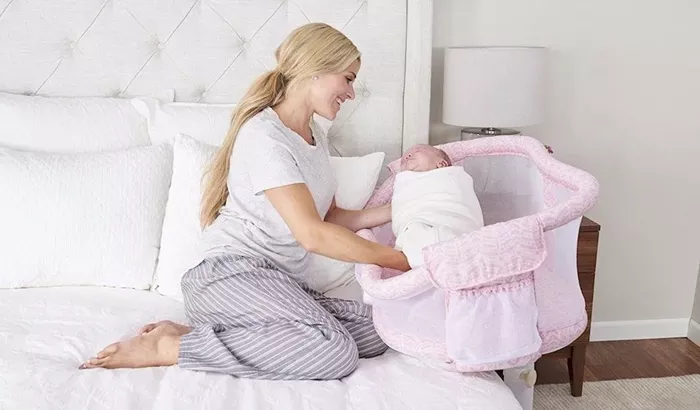A co sleeper bassinet is a special kind of baby bed designed to keep your newborn close while they sleep. It is like a small crib that attaches to your bed. This lets you be near your baby without sharing the same sleeping surface. Many parents find co sleeper bassinets helpful, especially during the first months after birth. They make night feedings and comforting easier. This article will explain what a co sleeper bassinet is, how it works, its benefits, safety tips, and how it differs from other baby beds.
What Is a Co Sleeper Bassinet?
A co sleeper bassinet is a bassinet that you place right next to your bed. One side of the bassinet can be lowered or removed so your baby is within arm’s reach. This design helps parents keep their baby close while giving the baby a safe, separate sleeping space. It is sometimes called a bedside sleeper or sidecar bassinet. Unlike bed-sharing, where the baby sleeps in the same bed as the parent, a co sleeper bassinet keeps the baby on a firm, flat surface next to you.
How Does a Co Sleeper Bassinet Work?
The co sleeper bassinet usually has four sides and a mattress inside. The side facing the parent’s bed can be dropped down or zipped open. This lets you easily reach your baby for feeding, soothing, or checking without getting out of bed. The bassinet is securely attached to your bed to prevent gaps where the baby could get stuck. It can also be used as a standalone bassinet by raising all sides. Most co sleeper bassinets are designed for newborns up to about 6 months old or until the baby starts to push up or roll over.
Benefits of Using a Co Sleeper Bassinet
1. Close Bonding and Comfort
Having your baby close helps with bonding. You can see and touch your baby easily, which can calm both of you. This closeness is comforting for newborns who are adjusting to life outside the womb.
2. Easier Nighttime Feeding
For breastfeeding mothers, a co sleeper bassinet makes night feeds simpler. You don’t have to get out of bed to feed your baby. This can help both mother and baby get more rest.
3. Safer Than Bed-Sharing
Unlike bed-sharing, co sleeper bassinets provide a firm, flat surface for your baby to sleep on. This reduces risks like suffocation, overheating, or accidental rolling over by a parent.
4. Helpful for Mothers Recovering from Birth
If you had a cesarean section or a difficult delivery, getting out of bed can be painful. A co sleeper bassinet lets you care for your baby without moving much, easing recovery.
5. Reduces Baby’s Fussiness
Babies often cry less when they feel close to their parents. Being near can help soothe your baby faster, leading to better sleep for everyone.
Safety Considerations for Co Sleeper Bassinets
Using a co sleeper bassinet safely is very important. Here are key safety tips:
- Ensure the bassinet is firmly attached to your bed with no gaps where the baby could get trapped.
- Use a firm, flat mattress that fits the bassinet perfectly. Avoid soft bedding, pillows, or blankets inside the bassinet.
- Make sure the bassinet meets safety standards such as EN 1130 or similar local regulations.
- Stop using the co sleeper bassinet once your baby can roll over, push up, or exceeds the weight limit.
- Keep the baby’s sleeping area free of toys, bumpers, or loose bedding to reduce suffocation risk.
- Always place your baby on their back to sleep to reduce the risk of Sudden Infant Death Syndrome (SIDS).
Co Sleeper Bassinet vs. Traditional Bassinet
Both co sleeper bassinets and traditional bassinets are small beds for newborns, but they differ in design and use:
| Feature | Co Sleeper Bassinet | Traditional Bassinet |
|---|---|---|
| Placement | Attached to parent’s bed, side lowered for easy access | Standalone, placed near the bed but not attached |
| Nighttime Feeding | Easier, can feed baby without getting out of bed | Requires getting up to reach baby |
| Size | Usually larger to fit alongside bed | Smaller and more portable |
| Use Duration | Typically used up to 6 months or until baby moves | Usually used up to 4 months or until baby moves |
| Safety | Designed to reduce bed-sharing risks | Safe separate sleep space but less accessible |
Who Should Consider Using a Co Sleeper Bassinet?
A co sleeper bassinet is ideal for parents who want to keep their baby close at night but still provide a safe separate sleep space. It is especially helpful for:
- Breastfeeding mothers who want easier access for night feeds
- Parents recovering from surgery or difficult births
- Babies who fuss or cry a lot when not near their parents
- Families wanting to reduce risks associated with bed-sharing
When to Stop Using a Co Sleeper Bassinet
It is important to stop using the co sleeper bassinet when your baby:
- Can roll over or push up on hands and knees
- Reaches the maximum weight or size limit set by the manufacturer
- Shows signs of increased activity that make the bassinet unsafe
At this point, moving your baby to a crib or toddler bed is safer.
Conclusion
A co sleeper bassinet is a practical and safe way to keep your baby close during sleep. It supports bonding, makes night feeding easier, and reduces risks compared to bed-sharing. By following safety guidelines and knowing when to transition your baby to a crib, you can enjoy the benefits of a co sleeper bassinet while ensuring your baby’s safety and comfort.
Related topics:


